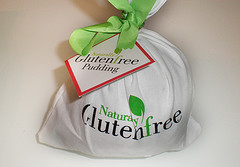 Gluten-free, vegetarian, and vegan are all the rage these days. Many people, whether they have a food allergy or not, believe that foods with these and other common labeling distinctions are automatically healthier than other foods. But do you really know what is contained in that gluten-free loaf of bread or those vegetarian "sausage" links? Chances are if it is packaged, processed, and contains more than about half a dozen ingredients on the label, it is still an unhealthy food, regardless of whether or not it contains wheat or animal-based products.
Gluten-free, vegetarian, and vegan are all the rage these days. Many people, whether they have a food allergy or not, believe that foods with these and other common labeling distinctions are automatically healthier than other foods. But do you really know what is contained in that gluten-free loaf of bread or those vegetarian "sausage" links? Chances are if it is packaged, processed, and contains more than about half a dozen ingredients on the label, it is still an unhealthy food, regardless of whether or not it contains wheat or animal-based products.But many health-conscious individuals trying to eat well remain largely unaware of this, assuming that because a food product does not contain certain ingredients that might be questionable, then it must not contain other harmful ones. More often than not, however, quite the opposite is true - foods that lack the basic ingredients required to produce a certain flavor or texture typically contain a host of other additives designed to mimic the original ones. And these additives, as you can probably imagine, are often extremely unhealthy.
Take the case of soy-based sausage and meat patties. These foods are typically marketed as being a healthy alternative for people trying to avoid meat-based products. But soy-based meat substitutes are not only loaded with highly-processed soy, which typically comes from genetically-modified (GM) soybeans, but they are also jam-packed with other flavoring and preservative chemicals like modified starches, various derivatives of monosodium glutamate (MSG), artificial colorings (to make them look like actual meat), synthetic vitamin fortifiers and other chemicals.
Gluten-free foods often loaded with refined sugar, processed oils, synthetic additives
The same is true for many gluten-free baked goods. Since gluten-free flours typically lack the chewy texture inherent in wheat-based products, they too are often loaded with additives that try to mimic these flavors and textures. And while some gluten-free products admittedly still contain only the most natural alternatives, many commercial varieties contain a laundry-list of unusual ingredients, many of which are likely of GM origin, that make them palatable for the average person.
"Few realize that when it comes to gluten free baked goods such as bread, snacks, and desserts, gluten free food is not as nutritious as 'regular' food," explains the blog ElanasPantry.com. "That's because gluten free foods are generally made with ingredients such as rice, corn, potatoes, sorghum, tapioca and millet, which are higher in carbohydrates and lower in protein and other nutrients than wheat flour."
Beyond this, gluten-free foods are also commonly bulked up with processed sugars and oils to make them taste more like the originals they have been designed to replace. This can lead to carbohydrate overload, and can actually be a cause of diabetes and other metabolic disorders later on in life. Some gluten-free products even contain blatantly harmful ingredients like high-fructose corn syrup (HFCS) and carrageenan, both of which are used to improve the texture of gluten-free products that would otherwise be dry and unappealing.
"You can't assume a food or a product is nutritious simply because it is gluten free," says nutritionist Monica Reinagel, host of the podcast Nutrition Diva. "Now we have a bit of a trap. Now it is easy to buy a lot of gluten-free junk food."







